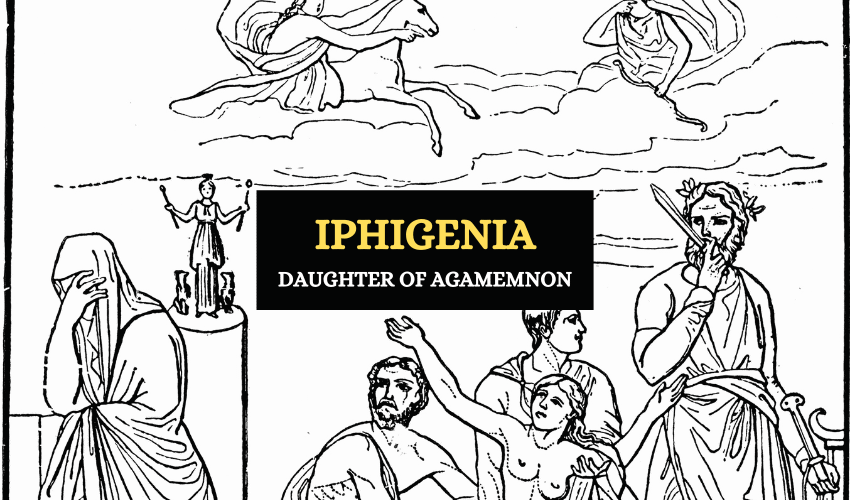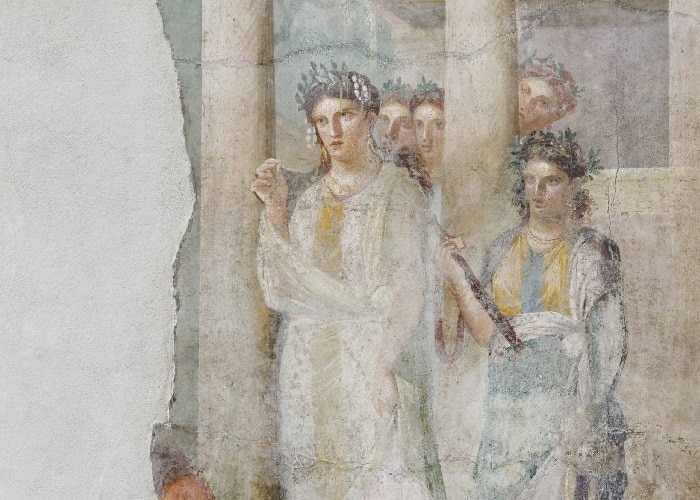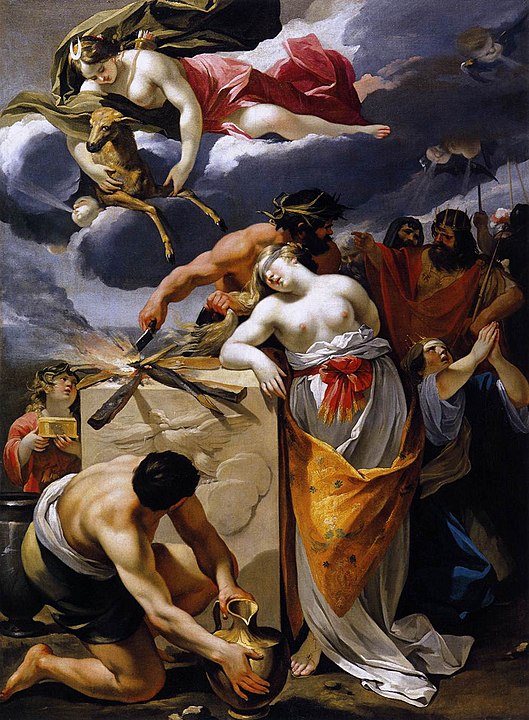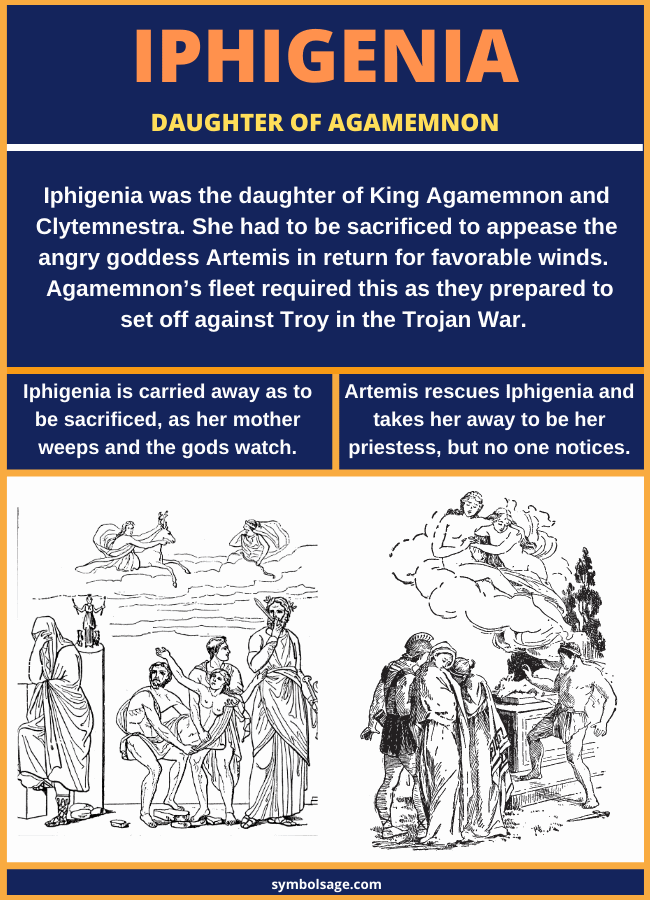
Table of Contents
Iphigenia was the eldest daughter of the king of Mycenae, Agamemnon, and his wife Clytemnestra. Unfortunately, through her father’s side, she belonged to the cursed House of Atreus and was possibly doomed from birth.
Iphigenia is mostly famous for the way she died. She was placed on the sacrificial altar by her own father who did this to pacify the goddess Artemis since he needed her help in the Trojan war. Here’s the story of the Princess of Mycenae and her tragic and untimely death.
Iphigenia’s Origins
Iphigenia was the first child born to Agamemnon and Clytemnestra. She had some famous relatives on her mother’s side including her aunt, Helen of Troy and grandparents Tyndareus and Leda. She also had three siblings: Electra, Orestes and Chrysothemis.
In a lesser known version of the story, Iphigenia’s parents were said to be the Athenian hero Theseus and Helen, born when Theseus took Helen from Sparta. Helen wasn’t able to take her daughter with her and had given her to Clytemnestra who raised Iphigenia as her own. However, this story is less common and is hardly ever referred to.

The Start of the Trojan War
It was believed that any member of the cursed House of Atreus was doomed to die sooner or later, but while most of the other members only made their predicament worse by their own actions, Iphigenia was completely innocent and unaware of what was about to befall her.
It all happened at the start of the Trojan war, when Iphigenia was still a young princess. While Menelaus was absent from Sparta, Paris abducted Helen and took her to Troy, while also stealing a large amount of Spartan treasure. Then, Menelaus invoked the Oath of Tyndareus, calling upon all of Helen’s suitors to protect Menelaus and retrieve Helen from Troy.
Iphigenia’s father hadn’t been one of Helen’s suitors, but he was known to be the most powerful king at that time. He became the commander of the army, gathering an armada of 1000 ships at Aulis. Everything was ready but there was one thing keeping them from setting sail and it was the ill wind, which meant that the Achaeans couldn’t sail for Troy.
The Prophecy of Calchas
A seer known as ‘Calchas’ told Agamemnon the Artemis, the goddess of hunting, chastity and wild nature was displeased with him. For that reason, she had decided to bring about ill winds and keep the fleet of ships at Aulis.
There could have been various reasons as to why Artemis had been angered but it seems the main one was Agamemnon’s arrogance. He had been boasting about his hunting skills and comparing them with those of the goddess. She didn’t like being treated with disrespect.
Calchas also told Agamemnon a way of appeasing the goddess but for this, a sacrifice would be required. It wasn’t to be a normal sacrifice, but a human sacrifice and it seemed the only victim suitable for this was Iphigenia.
Agamemnon’s Lie
The idea of human sacrifice wasn’t a common one in Greek mythology, but it did occur every now and then. For example, Athenians were offered as human sacrifices to the Minotaur and Lycaon and Tantalus killed their own sons as offerings to the gods.
What Agamemnon thought about sacrificing his own daughter depends on the ancient sources. Some say that Agamemnon was willing to make the sacrifice of his own daughter whereas other say that he was stricken with grief but had no other choice because it was his duty. Even if he wasn’t willing to go through with the sacrifice, it appeared that his brother Menelaus had convinced him to do it since plans for the sacrifice were being made.
At the time, Iphigenia was in Mycenae. When her mother, Clytemnestra, heard of the sacrifice, she wouldn’t allow it and there was no way of convincing her so Agamemnon decided not to try. Instead, he sent Odysseus and Diomedes back to Mycenae, to pass a message to Clytemnestra.
According to the message Clytemnestra received, she and Iphigenia were to come to Aulis, for Iphigenia was to marry the hero, Achilles. This was a lie but Clytemnestra fell for it. She and her daughter travelled to Aulis and upon arriving, they were separated from each other.
Iphigenia is Sacrificed
Iphigenia saw the sacrificial altar that was constructed and was aware of what was to become of her. While some say that she cried and pleaded for her life, others say that she climbed onto the altar willingly since she believed that it was her destiny. She also believed that she would be known for dying a hero’s death. However, when it came to choosing the person who would sacrifice Iphigenia, none of the Achaean heroes wanted to go through with it. It eventually came down to Calchas, the seer, and so he wielded the knife to perform the sacrifice.

Was Iphigenia Saved?
In the well known, simple version of the myth, Iphigenia’s life was ended by Calchas. However, in Greek mythology, human sacrifices didn’t always end the way they were supposed to.
According to certain sources, Calchas was unable to go through with the sacrifice since the goddess Artemis intervened. She spirited the princess away, and left a deer in her place. Artemis made sure that everyone who witnessed Iphigenia’s sacrifice didn’t realize that she had been replaced by a deer, except for Calchas who remained silent.
After the sacrifice had been performed, the ill winds abated and the way was clear for the Achaean fleet to being their journey to Troy.
The Consequences of the Sacrifice
Iphigenia’s sacrifice (or supposed sacrifice), had dangerous consequences for Agamemnon. After surviving the battle at Troy for ten years, he was murdered by his wife Clytemnestra when he finally returned home. Clytemnestra was angry at Agamemnon for sacrificing their daughter and she, together with her lover Aegisthus, killed Agamemnon while was taking a bath.
Iphigenia in the Land of Tauris
After the death of her father Agamemnon, the story of Iphigenia began to remerge in Greek mythology as she appeared in the myth of Orestes, her brother. When Artemis took Iphigenia way from the sacrificial altar, she had transported her to Tauris, now known as Crimea.
Artemis appointed the Mycenaen princess as a priestess of her temple there. The Tauri sacrificed every stranger that stepped on their land and although she herself had escaped from being a human sacrifice, Iphigenia was now in charge of them.

Orestes and Iphigenia
Many years after, Orestes, Iphigenia’s brother, came to Tauris. He had killed his mother to avenge his father’s death and was now being followed by the Erinyes, goddesses of retribution and vengeance. Orestes came with his cousin, Pylades, but since they were strangers, they were arrested at once and were ready to be sacrificed.
Iphigenia came to see them, but the siblings couldn’t recognize each other. However, Iphigenia offered to release Orestes only if he would take a letter to Greece. Orestes didn’t like this because he knew it meant that Pylades would have to remain behind to be sacrificed so he asked for Pylades to be sent with the letter instead.
The letter is said to have been the key to the siblings recognizing each other and together with Pylades, the three of them boarded Orestes ship. They left Tauris with a statue of Artemis.
Iphigenia Returns to Greece
Before Iphigenia, Pylades and Orestes returned to Greece there were already rumours spreading around that Orestes had been sacrificed in Tauris. Iphigenia’s sister, Electra, was devastated when she heard this and she travelled to Delphi to find out what her future would hold. Electra and Iphigenia both arrived in Delphi at the same time but they didn’t recognize each other and Electra thought Iphigenia was the priestess who had sacrificed her brother.
Therefore, Electra planned to kill Iphigenia but just as she was about to attack her, Orestes intervened and explained everything that had happened. Finally united, Agamemnon’s three children returned to Myenae, and Orestes became the ruler of the kingdom.
The End of Iphigenia
In some accounts, Iphigenia died in a town called Megara which was the home of Calchas, the seer who had almost sacrificed her. After her death, it’s said that she resided in the Elysian Fields. Some ancient sources state that she wed Achilles in the afterlife and together, the two spent an eternity on the Isles of the Blessed.
Iphigenia in Popular Culture
Iphigenia’s story has been written about by various writers throughout history. However, she’s not mentioned in Homer’s Iliad and the myth was dramatically altered depending on the audience it was being written for. Her story has also been used in many television productions and has inspired many great works of art by famous artists.
Some examples include the movie The Killing of a Sacred Deer, the play Even Kins Are Guilty and the comic book series Age of Bronze.
Facts About Iphigenia
- Who are Iphigenia’s parents? Iphigenia’s mother is Clytemnestra and her father is King Agamemnon.
- Who did Iphigenia have to die? Iphigenia had to be sacrificed to appease the angry goddess Artemis in return for favorable winds for Agamemnon’s fleet to set off against Troy.
- How does Iphigenia die? Iphigenia is sacrificed to Artemis. In some versions, she’s rescued by Artemis and taken away to be a priestess of Artemis.
In Brief
Many people are unfamiliar with the complex story of Iphigenia but her story is important, and links with many other well-known tales including the Trojan War, Orestes and the House of Atreus.








